Sergeant Major
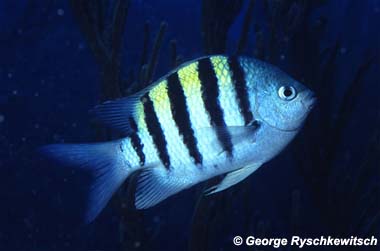
Abudefduf saxatilis
This small, flat, oval shaped reef fish has five distinct black bars on its sides. While in sandy areas and over reefs, it is in its light phase, generally silvery gray with a yellow sheen along its upper sides; and when hiding in a cave or crevice, it enters its dark phase, with its body going darker gray blue, almost blending in with its dark bars.
Named from the military stripes they resemble, the sergeant majors school in groups of hundreds for feeding, but during spawning season, the male will aggressively guard his nest.
Order – Perciformes
Family – Pomacentridae
Genus – Abudefduf
Species – saxatilis
Common Names
English language common names are sergeant major, damsel fish, five finger, and pilotfish. This fish gets its common name “sergeant major” from the stripes that resemble the traditional insignia of the military rank. Other common names include asan (Malay), badret (Marshallese), bakej (Marshallese), bitoke (Marshallese), burrinho (Creole /Portuguese), camiseta (Portuguese), castagnole (French), castanheta (Portuguese), chauffet soleil (French), ega’aisse (Arabic), garbik pasiasty (Polish), isdang san ramon (Visayan), kalli (Malayalam), laslas (Samal), limoulaang (Carolinian), makhrev (Arabic), mamo (Tahitian), patima-mashowera (Swahili), pesce damigella (Italian), petaca rayada (Spanish), pintano (Spanish), sargento (Portuguese), sergent major(French), shibubu (Arabic), and urel (Marshallese).
Importance to Humans
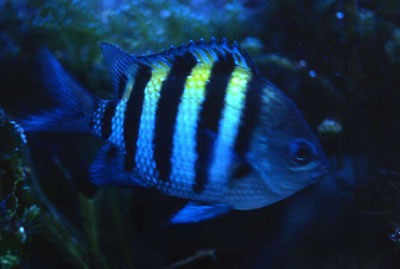
The sergeant major is of only minor importance to commercial fisheries, however when it is caught it is marketed fresh. It is of interest to public aquarium facilities for coral reef display tanks and it is attracted to divers who feed fish.
Conservation
The sergeant major is not considered as endangered or vulnerable with the World Conservation Union (IUCN). The IUCN is a global union of states, governmental agencies, and non-governmental organizations in a partnership that assesses the conservation status of species. The global trend of coral reef destruction could result in future endangerment.
> Check the status of the sergeant major at the IUCN website.
Geographical Distribution

The range of the sergeant major is worldwide in warm waters. In the Atlantic Ocean, this fish occurs from Rhode Island (U.S.) to Uruguay. It is quite abundant on Caribbean Sea reefs as well as around islands in the mid-Atlantic region. In the eastern Atlantic Ocean, its range includes Cape Verde, along the tropical coast of western Africa, south to Angola.
Habitat
This reef-associated fish is commonly observed forming large feeding aggregations of up to a few hundred individuals. These schools swim over shallow reef tops at depths of 3-50 feet (1-15 m). Feeding aggregations remain low in the water column prior to dusk, with fish scattering with the approach of night, seeking the cover of caves and crevices within the reef. Those settling in caves face outward, hovering in place, while those taking refuge in holes tilt sideways, leaning against something. The cave hiders take on the dark color phase (see Color section for more details on the color phases).
Juveniles are found in specific habitats, often schooling close to caves, shipwrecks, or other protective objects. Juveniles school or defend territories depending upon the surrounding environment. They are also commonly associated with floating sargassum communities. Sergeant majors swim primarily with their pectoral fins while schooling, utilizing their caudal fins for navigating caves and avoiding predators.
Biology
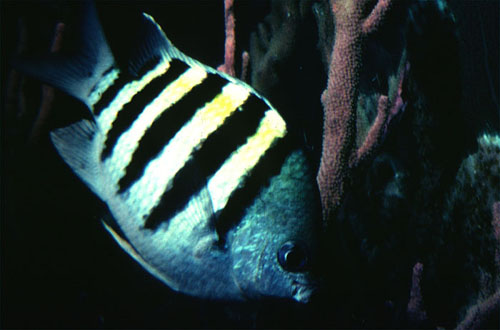
Distinctive Features
The sergeant major is a small, rounded fish with the body compressed laterally. It has a single nostril on each side of the snout, rather than two as in the butterflyfishes and angelfishes. The mouth is small and terminal. This fish is often confused with Abudefduf taurus, the night sergeant. However, the vertical bars of the sergeant major are more pronounced and it has a slimmer body. There is also much less distance between the eye and the upper margin of the mouth in A. saxatilis than in A. taurus.
Coloration
There are two color phases: the light phase is observed when the fish is over a light sandy bottom or swimming above the reef while the dark phase is evident when the fish is hiding among the rocks and crevices within the reef. The light phase is characterized by the gray coloration of the lower body and entire head, often with a hint of green. The upper third of the body is yellow while the soft dorsal, caudal, and anal fins appear dusky.
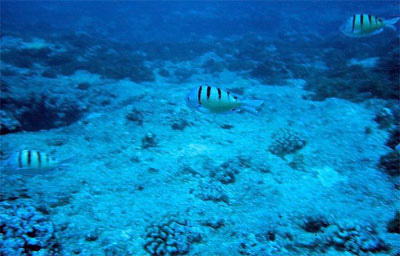
There are five prominent vertical black bars on the body, becoming narrow toward the belly. Sometimes a faint sixth bar may be seen on the caudal penduncle. There is a black spot at the upper base of the pectoral fin. In dark phase fish, the body is dark gray or bluish with the color sometimes dark enough to hide the black vertical body bands. This coloration is also often observed in the males during spawning and nest guarding activities.
Juveniles are always in the light coloration phase except for those associated with sargassum communities. Occasionally the juveniles appear solid black but never at sizes larger than 20mm. The vertical black bars may be indistinct on very young individuals and the fins colorless.
Size, Age, and Growth
The maximum length of the sergeant major is approximately 9 inches (23 cm), while the maximum weight is up to 0.45 pounds (0.2 kg). Males reach maturity at lengths of 3.9 inches (10 cm) and females at 3.1 inches (8 cm).
Dentition
The upper jaw of the sergeant major is large and contains smaller than other Abudefduf species. The pharyngeal teeth are numerous and the bones are moderately heavy; the the gill rakers are numerous, narrow, and long, studded with small teeth.
Food Habits
The sergeant major feeds on a variety of food items including algae, small crustaceans, various invertebrate larvae, and fishes. Stomach content analysis reported benthic algae, pelagic algae, and plankton including copepods, shrimp larvae, fish, and pelagic tunicates as specific prey items of this fish.
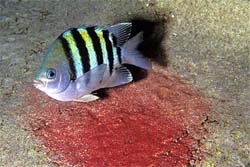
Reproduction
Spawning occurs on rocks, shipwrecks, pilings, and reef outcroppings where the male sergeant major prepares the nest. In Jamaica, spawning occurs from November through April while in the Bahamas, spawning season ranges from June to August. Courtship rituals include males actively chasing the female during the morning hours. During this time, the males build nests.
During spawning, approximately 200,000 eggs are released. These eggs are salmon or red colored, oval-shaped, and 0.5-0.9 mm in diameter. Upon fertilization, the eggs turn greenish at 96 hours and contain a deep red yolk. An adhesive filament attaches the egg to the bottom substrate.
The male sergeant major takes on a bluish color while guarding the fertilized eggs. He guards them until they hatch which occurs within 155-160 hours following fertilization. This guarding of the eggs, characteristic of the family Pomacentridae, is unusual since most reef fishes have a planktonic stage. The larvae reach 2.4 mm in length approximately 36 hours after hatching. They are deep-bodied, with the caudal and pectoral fins visible, prominent lips, and well-developed jaw bones.
Parasites
Nematodes, digenetic trematodes, cestodes, and crustaceans are among the parasites that are associated with the sergeant major. Parasitic fauna is largely dependent upon habitat and diet of this fish.
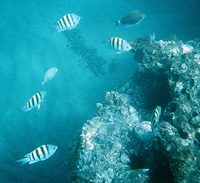
Predators
Predators of the sergeant major include cobia (Rachycentron canadum), bluehead (Thalassoma bifasciatum), Nassau grouper (Epinephelus striatus), great barracuda (Sphyraena barracuda), bar jack (Caranx ruber), and cero mackerel (Scomberomorus regalis) among many other large carnivorous fishes.
Taxonomy
The sergeant major was first referred to as Abudefduf saxatilis by Carl Linnaeus (1758). The scientific name abudefduf translates as “father”, saxa as “living among rocks”, and tilus as “tile-like in color”. It is called father due to its bossy, aggressive behavior towards other inhabitants on the reef. Synonyms include A. marginatus Bloch 1787, Chaetodon marginatus Bloch 1787, Chaetodon mauritii Bloch 1787, Glyphisodon moucharra Lacepede 1802, Chaetodon sargoides Lacepede 1802, Glyphisodon biniar Montrouzier 1857, Apogon quinquevittatus Blyth 1858, and Abudefduf ascensionis Fowler 1919.
Prepared by: Cathleen Bester